Chimney for a gas boiler: types of structures, installation tips, standards and installation requirements
If gas is chosen for heating in the house, care should be taken for the removal of combustion products. This means that you need to choose and correctly install the chimney for the gas boiler. Compliance with the rules and regulations in this matter should not be neglected, since this can call into question not only health, but also the life of the residents of the house.
We are ready to share with you useful information about the rules for installing and connecting a chimney for a gas unit, about the specifics of choosing the optimal design. The information is supplemented by visual illustrations and video instructions.
The content of the article:
- Why do you need a chimney at all?
- Selection of materials for the construction of the chimney
- Subtleties of designing a smoke channel
- Rule # 1 - compliance with the norms of the cross-section of the channels
- Rule # 2 - Condensate Management
- Rule # 3 - choosing the sectional shape of the structure
- Rule # 4 - the implementation of biases, turns, ledges
- Rule # 5 - Correct Pipe Connection
- Rule # 6 - the subtleties of the location of the pipe on the roof
- Rule # 7 - Fire Safety Compliance
- Chimney selection depending on the type of boiler
- Preliminary calculations of the chimney parameters
- Chimney mounting options
- How to remake an old chimney?
- Conclusions and useful video on the topic
Why do you need a chimney at all?
One of the most dangerous products resulting from almost all types of combustion is carbon monoxide. This is an insidious and very dangerous substance, the inhalation of which threatens with severe forms of poisoning.
During the operation of a gas boiler in the process of fuel combustion, in addition to other combustion products, carbon monoxide is also formed.
If the chimney venting the combustion products is not installed correctly or is damaged, this can lead to poisoning.
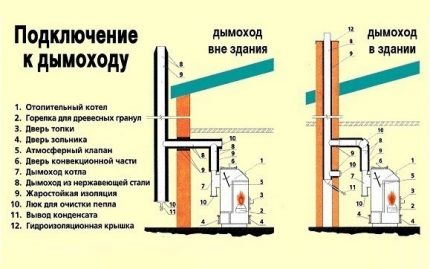
Danger should not be underestimated.Carbon monoxide (aka carbon monoxide) is odorless and colorless, so poisoning can occur completely unnoticed by everyone in the house.
Once in the human body, carbon monoxide molecules interact with hemoglobin. As a result, the so-called carboxyhemoglobin is formed, which prevents the entry of oxygen molecules into the tissues of the human body.
In addition, carbon monoxide can very badly affect other biochemical processes in the body. There were times when carbon monoxide poisoning was detected too late, a person simply could not be saved.
To avoid such problems, it is recommended to pay close attention to the correct design and installation of the chimney, as well as to its further maintenance.
Selection of materials for the construction of the chimney
The gases discharged through the chimney of a boiler operating on this fuel have a low temperature - about 150⁰, therefore, the requirements for the material of the chimney are somewhat different.
When it is burned, steam is formed with an admixture of carbon dioxide - the substances are neutral, not contributing to the occurrence of destructive processes, but, besides them, aggressive sulfuric acid is also present in the combustion products.
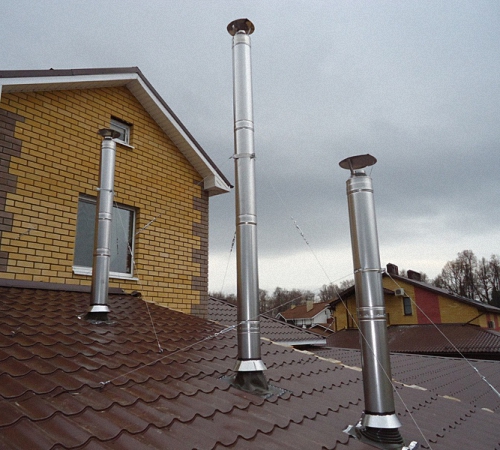
At gas heating device country house and chimney for a gas boiler should use only very durable materials that are resistant to many external factors. They must be fire resistant, able to contact with moisture and acids released during gas combustion and deposited on the walls of the chimney in the form of condensate.
When choosing a material, it is necessary to pay attention to such a parameter as the gas permeability of the material. It must be zero. In addition, the material should not be too heavy, since such a design creates additional load on the walls and foundation of the house.
Homeowners are increasingly opting for lightweight acid-resistant stainless steel pipes, using furanflex, protective sleeves, and ceramic modules.
Stainless steel chimneys
Such designs are considered the best choice. They are extremely resistant to many types of corrosion, have a relatively light weight and provide excellent traction. The life of a chimney made of steel is usually about 15 years.
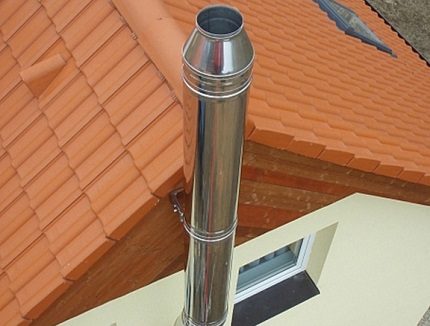
Galvanized steel with the removal of combustion products copes much worse than stainless steel. Wet and hot vapors with high acidity quickly destroy this material. The galvanized chimney will have to be replaced in five years.
Ceramic chimneys
They have an exceptionally high service life - they can last up to 30 years. Especially popular and convenient are models of European production with an external steel contour.
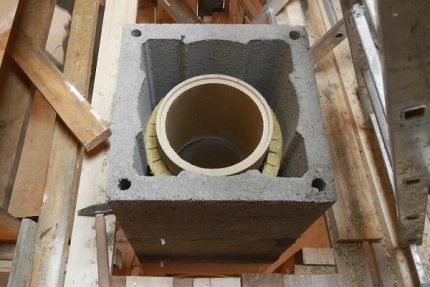
But this option has a number of serious drawbacks:
- The high weight of the structure, which should be correlated with the bearing capacity of the foundation and walls of the house.
- Increased installation requirements. It is believed that for maximum traction ceramic chimney It should be located strictly vertically, and this configuration is convenient far from everywhere.
Coaxial Chimney
Coaxial chimney flue - the choice is highly efficient, modern, but expensive. The design of such a chimney represents two pipes embedded in each other. Combustion products are discharged through the inner pipe, and the outer one is used to supply air.
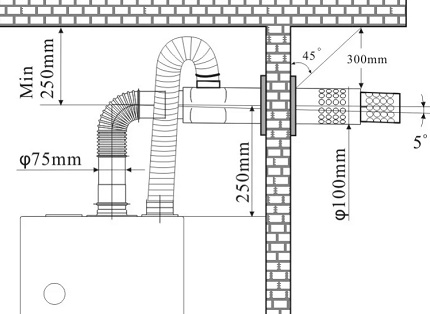
Coaxial chimney is also supplied in the form of modules, which facilitates its assembly and installation. Another advantage is the increased level of security. This, of course, if during the installation process the installation norms of the coaxial chimney and construction rules were observed.
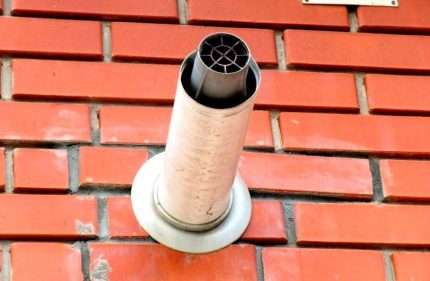
Brick chimney
This is not the best option for a gas boiler. Massive construction usually does not differ in good traction, it weighs too much and does not last long. It is often necessary to clean such a chimney, a lot of condensate accumulates on its surface, therefore, its service life when used with gas equipment is small.
The brick channel is also dangerous due to the fact that due to the roughness of the inner walls at low outside temperature, an effect may occur reverse thrust or a water plug will form, which will lead to the cessation of the combustion process.
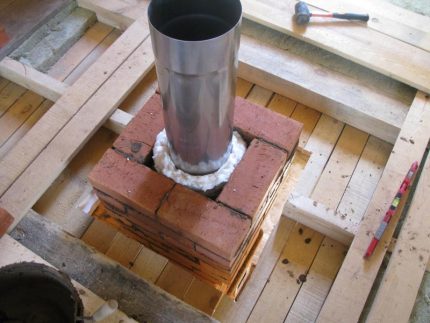
But if the house already has an old brick chimney, it can be used. A special stainless steel insert is inserted inside the structure, and the brickwork becomes a protective case. Of course, the diameter of the liner and its configuration must comply with the standards described above.
Chimneys from asbestos-cement pipes
Such designs are quite rare. They are superseded by more efficient materials. If you buy a relatively inexpensive asbestos-cement pipe, then its installation is complicated by the fact that it has a large mass and must occupy a strictly vertical position.
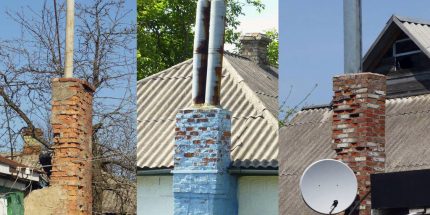
Due to its drawback, the arrangement of such an option is strictly not recommended. It is budgetary, of course, but can your health be estimated in money? The life of an asbestos-cement chimney does not exceed five years.
It is recommended to equip all options for chimneys for gas equipment traction amplifiers.
Subtleties of designing a smoke channel
At chimney design everything has a value: its size, configuration, section, slope, and other parameters. When installing a chimney from a gas boiler, it is necessary to strictly adhere to the requirements of regulatory documents: SNiP 2.04.05-91 and DBN V.2.5-20-2001.
Rule # 1 - compliance with the norms of the cross-section of the channels
The cross section of the chimney channel over the area should be no less than the cross section of the nozzle of the gas boiler, with which the device is connected to the chimney.
During the construction and connection of chimneys for gas boilers over their entire length, narrowing of the channel, curvature and the use of modules that are not suitable for the cross section are unacceptable.
When two devices are connected to the chimney at the same time, the cross-section should be increased taking into account the probability of two devices working simultaneously. Those. the cross section of the channel should be equal to the total size of the nozzles of both pieces of equipment.
Rule # 2 - Condensate Management
Modern gas boilers are designed so that the maximum amount of heat is supplied to the heat exchanger. Such a high efficiency contributes to the production of combustion products with a relatively low temperature.
As a result, moisture forms on the walls of the chimney. An increased amount of condensate, including aggressive substances, can have a destructive effect on the integrity of the chimney walls.
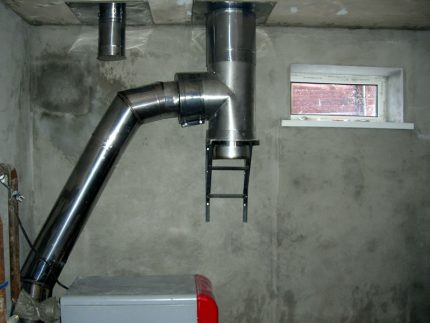
In the lower part of the chimney, the presence of a condensate collector in the form of a removable container made of plastic or stainless steel is necessary. It is not forbidden to use a glass made of galvanized steel, but it will often have to be changed.
To protect the structure, it is recommended not only to lay the chimney out of brick, but also to perform its casing, i.e. insert a special stainless steel pipe inside. Such pipes are durable and well resist corrosion.
An alternative solution for condensate control may be lining, i.e. installation of a special flexible chimney. A special container is used to collect condensate. It is installed just below the place where the boiler pipe connects to the chimney.
Rule # 3 - choosing the sectional shape of the structure
The traditional cylindrical shape of the chimney is considered optimal for the effective removal of combustion products. In addition, preventive cleaning is easier in such a chimney.
Chimneys with an oval cross-section are considered quite acceptable, although not so convenient. Square structures also have a right to exist, but traction in them is usually reduced.
Rule # 4 - the implementation of biases, turns, ledges
The optimal for a floor gas boiler is a vertical chimney that does not have ledges. In practice, it is far from always possible to achieve this arrangement of the structure.
Deviation from the vertical is allowed no more than 30 degrees. It should be ensured that the cross-sectional dimensions of the inclined section comply with regulatory requirements.
In this case, the pipe itself connecting the chimney and the boiler should include a strictly vertical section with a height of half a meter or more. Of course, if necessary, some sections of the chimney can be made horizontal, but there should not be too many of them.
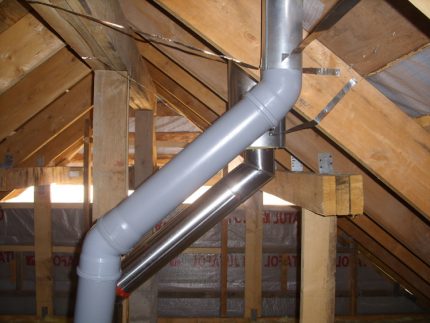
For example, if the height of the room in which the chimney is installed is about three meters, then the total length of the horizontal sections of the chimney should not exceed these dimensions.
Although, as mentioned earlier, the closer the design of the chimney to the vertical, the better. It is not allowed that the chimney slope towards the boiler is more than 0.1 degrees. As for the turns of the chimney design, their maximum number is three turns, no more.
Rule # 5 - Correct Pipe Connection
To connect the individual parts of the chimney structure using special clamps. The slope of the knee of the chimney design can be 15-90 degrees. A certain distance must be maintained between the connecting pipes and the rest of the surfaces.
It depends on what materials these surfaces are coated with. In places where combustible or even hardly combustible materials are used, it is recommended to maintain a distance of at least 25 cm.
The distance from surfaces covered with fire-resistant materials should be at least 5-10 cm. To protect the chimney from flammable materials, asbestos board, brickwork, etc. are used.
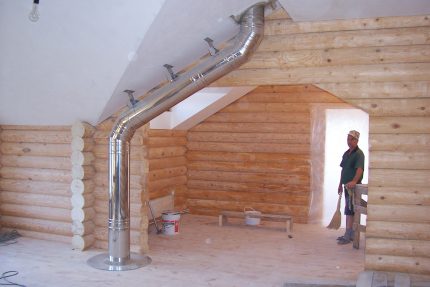
Particular attention should be paid to the junction of individual sections of the chimney structure. They should be made of durable materials that do not bend when exposed to external factors.
All chimney fasteners must have the same characteristics. Horizontal or inclined sections of the chimney must not be under load.
The elements of the chimney are inserted into each other to a depth that is equal to half the diameter of the pipe or exceeds this indicator. No gaps in these places are unacceptable, the connection must be tight and tight.
In the event of a leak in the connection of individual elements of the chimney, carbon monoxide can imperceptibly enter the room. Therefore, the condition of the chimney should be checked periodically, and in all rooms where chimneys are laid, it is necessary to organize good ventilation.
Rule # 6 - the subtleties of the location of the pipe on the roof
Chimneys should rise above the roof ridge by 50 cm or more, while the distance from the edge of the parapet to the chimney should be no more than 150 cm.If the axis of the chimney is located at a distance of 1-1.5 m from the ridge of the roof, then it should rise above the level of the ridge by 50 cm or more.
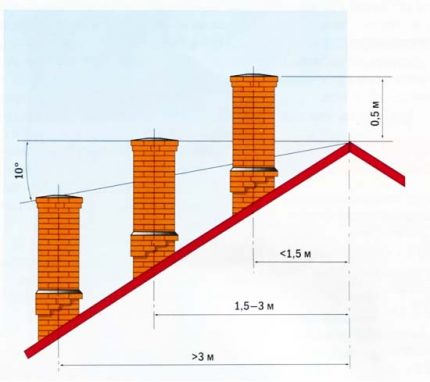
If the work is even further from the ridge, then it can be made of the same height as the ridge. The pipe may be even lower if it is separated from the roof ridge by a distance of more than three meters.
In this case, you need to draw a conditional line down from the ridge at an angle of 10 degrees to the horizon. The height of the chimney should reach this mark. It turns out that the farther the pipe is from the ridge, the lower its height relative to the ridge of the roof should be.
There is no chimney on a flat roof, therefore, in accordance with the standards, a chimney pipe 100 cm high is erected here. On a combined roof, the height of the chimney pipe should be about two meters.
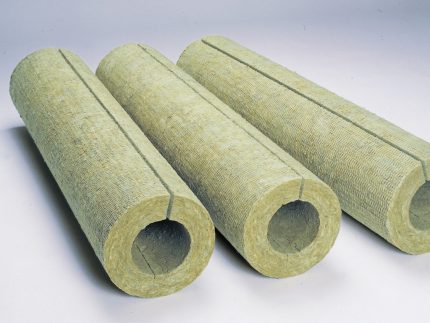
The outer part of the chimney must be insulated. If this moment is neglected, condensate will accumulate on its surface. Moisture can penetrate inside the chimney, which will lead to the development of corrosion processes and damage to the structure.
The part of the chimney structure that is located on the outside of the house also needs insulation. Insufficient insulation can also reduce the efficiency of the chimney, reduce its draft.
If it is not possible to remove the chimney through the upper ceiling and roof, use coaxial chimneys. This option can be led out through the wall, while the intensity of the removal of combustion products of blue fuel is not reduced at all.
Rule # 7 - Fire Safety Compliance
At the stage of installation of the chimney, it is necessary to take into account the fire safety requirements. When a channel passes through walls of different materials, they differ:
- if the wall is made of wood, insulation around it is made of fire-resistant material, and the pipe itself should be wrapped with asbestos;
- in a brick, concrete wall there is enough insulation from polyurethane foam.
The design of the chimney must comply with the requirements set forth in the instructions attached to the boiler.
Chimneys of boilers that process gas into thermal energy, mainly of a packed structural type. According to the nozzle scheme, the channel is installed directly on the floor slab of the heating unit. However, it is permissible to connect to wall chimneys by means of nozzles with a length of not more than 40 cm.
In the case of connecting to the wall chimney, a gap of 14 cm should remain between the lower line of the nozzle and the flammable ceiling. Between the upper line of the nozzle and the flammable ceiling, leave 50 cm if there is no fire protection, 40 cm if there is protection.
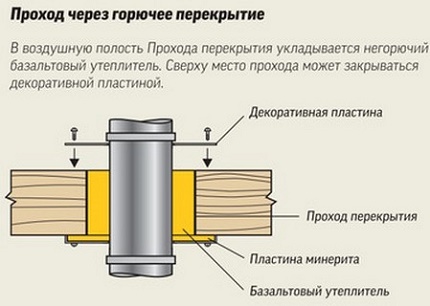
The intersection of the combustible floor is equipped with a box of sand or a seal of fireproof insulation.
Chimney selection depending on the type of boiler
Gas boilers are equipped with one of two types of combustion chambers: open or closed. Externally, the heating units are no different, but the principle of operation is different. The choice of design of the chimney is carried out depending on the type of combustion chamber.
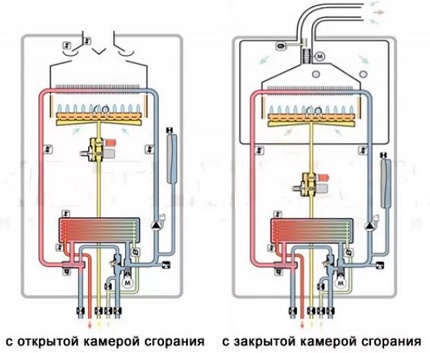
The location of the chimney must also be determined in advance. It can be both internal and external. In projects of new homes, installation of indoor chimneys is usually provided. When old houses are converted to gas heating, a remote chimney is arranged.
Chimney for boiler with open burner
A simpler device has an open camera. It consists of the burner itself and the coil located under it. The latter consists of thin tubes through which the coolant circulates. The device only works when air is present, so the burner is called atmospheric.
Such a boiler receives air from the room where it is installed, although there are models that mount on the wall and make an air inlet in it.
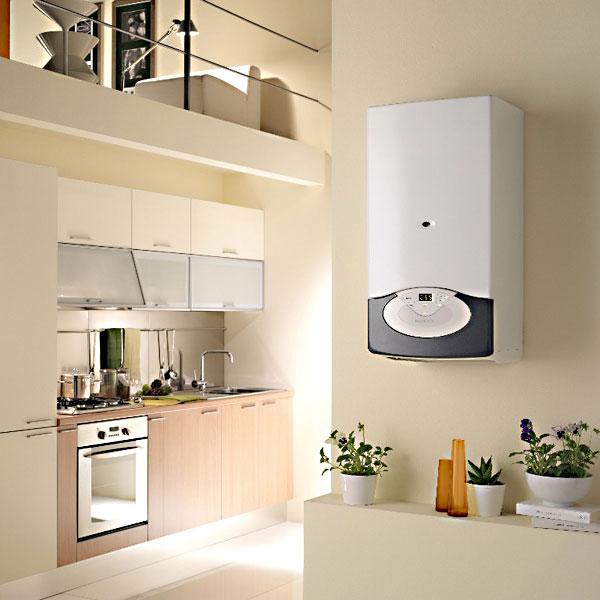
For the boiler to work well with an open chamber, you need a pipe that goes out and an excellent draft that occurs when air moves through the smoke exhaust channel. The unit is well suited when it is required to heat a house of a large area, located outside the city limits.
There are 2 solutions:
- The most straight pipe, located horizontally, is drawn through the wall, and from the outside it is directed upwards along the wall to the desired height. This version of the chimney is called outdoor.
- From the boiler, the pipe is pulled up. It should go through the overlap and go over the roof surface. In such a chimney, it is permissible to make 2 bends of 45⁰.
The first option is simpler to execute, but high-quality insulation is required. This will reduce the amount of condensate, but completely eliminate it. At the outlet, a condensate collector and a tee are required.
The application of the second option is complicated by the fact that the chimney passes the ceiling and the roofing cake. Therefore, in these places, in accordance with the requirements of fire safety, the installation of ceiling-passing units will be required.
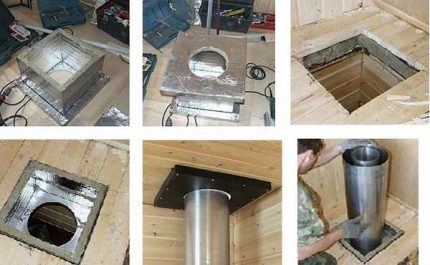
There are terms such as installing a chimney “smoke” and “condensate”. Assembly according to the first method is carried out when the internal chimney is installed, and according to the second, when the external chimney is being erected.
In the first case, the already installed lower element is inserted into the upper one, which will prevent the leakage of gases into the room. In the second, they do the opposite.
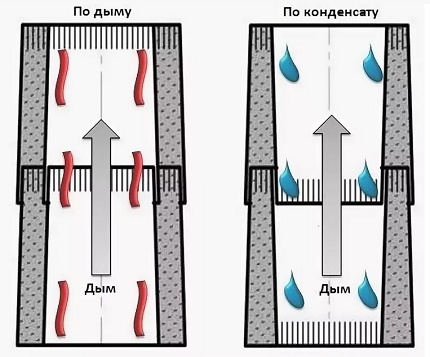
If the pipe is brought to the residential 2nd floor, it must be brought in an aesthetic appearance. For this, special screens are used, which are fixed to the floor with self-tapping screws. When the chimney enters the attic, no additional work is required.
Chimneys for turbocharged boilers
Boilers with a blast burner are called turbocharged. This is a more progressive design with forced injection of oxygen and a closed chamber with a nozzle located in it. Air comes from a fan installed externally through a special channel.
The heating block has double walls, between which there is water. The liquid heats up when the gas burns, and the supercharger displaces the combustion products into the chimney.
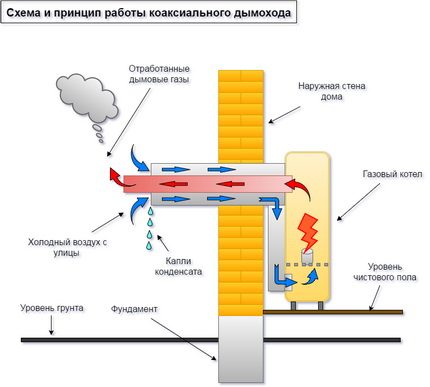
A coaxial chimney is suitable for a turbocharged boiler.Through one of its pipes, exhaust gases are removed up to 3 m, and through the other, air is supplied that is necessary for the combustion process.
In terms of ecology, such an aggregate is safer, the combustion process controls automation for gas boilers. The fuel in it burns out almost 100%. The efficiency is greater because the water is in contact with the walls of the chamber.
Perhaps the use of horizontal short chimneys. As a result of using a double pipe, the air coming from the street is heated due to the heat transfer from the exhaust gases.
Chimney arrangement specifics for two boilers
Each device using gas as a fuel must have an individual chimney. In case of urgent need, as an exception, it is permissible to connect 2 units of simultaneously working, gas-consuming equipment. The main condition is to observe a minimum distance of 0.7 m between the points of the pipe insert into the chimney.
If the house has not only a gas boiler, but also other heating or water heating equipment, the following standards should be considered:
- No more than two such devices located on one floor or on different floors can be connected to one chimney.
- In this case, the holes for the removal of combustion products for these devices must be at different levels.
- The entrances to the chimney should be separated by a distance of 50 cm or more.
- The introduction of combustion products from two devices at the same level is allowed only if there is a special dissecting insert inside the chimney.
- In this case, the height of the parallel inputs into the chimney, equipped with a divider, must be at least one meter.
Of course, the construction of several chimneys will cost more than just one design, but do not neglect the requirements of building codes and safety rules for the sake of dubious savings.
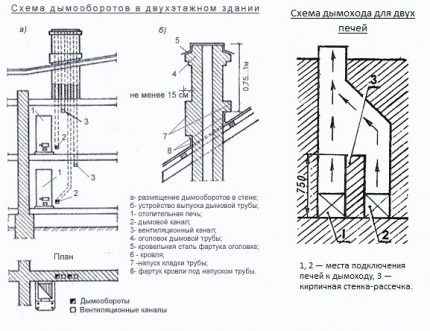
When creating a chimney, materials with a low density and high porosity, which differ in foam and slag concrete blocks, should not be used. The chimney must not pass through residential premises.
Installation of such structures is also not allowed on closed loggias or balconies. In all rooms where there is a chimney, it is necessary to organize proper ventilation.
Preliminary calculations of the chimney parameters
Chimney selection should begin only after the purchase of the boiler, otherwise it is impossible to choose its cross section and calculate the dimensions. The best shape is a round section, although a rectangle is also acceptable.
Indicative list of structural elements of the chimney:
- an adapter connecting the boiler nozzle to the chimney design;
- tee with inspection hole and fitting designed to collect condensate;
- clamps for connecting individual elements of the chimney;
- brackets and other fasteners;
- conical tip;
- telescopic pipes;
- bends;
- bushing, etc.
It should be remembered that bends are usually recommended to be installed at a distance of no more than two meters from the nozzle of the gas boiler. This will provide the most effective traction.
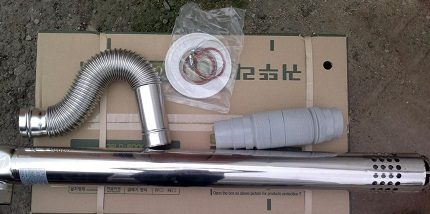
For proper installation of the chimney, it is recommended that you first calculate the cross-sectional area of the outlet.
In this case, use the formula:
F = (K ∙ Q) / (4.19 ∙ √ˉ H),
Where:
- K - a constant coefficient, its value varies between 0.02-0.03;
- Q - gas boiler performance indicated in the technical passport of the device;
- N - the estimated height of the chimney.
After the cross-sectional area is calculated using this formula, it is necessary to compare the data obtained and adjust them if necessary.
For example, according to the requirements for the chimney of a gas boiler, for round structures, the recommended section depends on the capacity of the boiler and may leave:
- 120 mm for a 24 kW boiler;
- 130 mm - for 30 kW;
- 170 mm - for 45 kW;
- 190 mm - for 55 kW;
- 220 mm - for 80 kW;
- 230 mm - for 100 kW.
If a chimney with a rectangular cross section is mounted, the thermal power of the gas equipment is taken into account:
- for devices with a power of less than 3.5 kW - 140x140 mm;
- for devices with a power of 3.5-5.2 kW - 140x200 mm;
- for devices with a power of 5.2-7.3 kW - 140x270 mm, etc.
If asbestos-cement pipes are used, the cross section of the chimney channel must be at least 100 mm. Vertical sections of the chimney are fixed on the wall in increments of 2.5 m, and in areas with a slope, the step should be more often - 1.5 m.
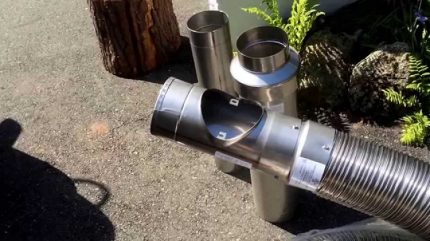
The height of the chimney is chosen depending on its location in relation to the ridge of the roof.
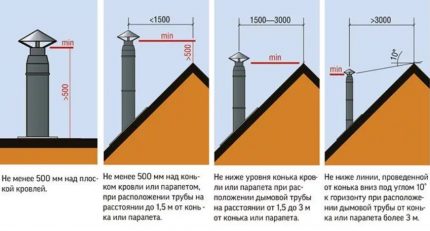
If, during the calculation, it turns out that the condition is not met under which the useful section of the pipe should be larger than the internal area of the heating unit, a pipe of a smaller section, but of a greater length, should be taken.
Chimney mounting options
Under the internal chimney, it is necessary to build a foundation. If you also add a protective brick channel, then this will minimize the amount of condensate. Sometimes chimneys are attached externally to the wall behind which the unit is located.
Internal chimney design
Before proceeding with the installation of the chimney, a place is chosen for it. Then mark the places where it will pass through the ceiling and roof. Carefully check the accuracy of the layout and make openings. The next step is to connect the boiler pipe to the chimney, and then install the revision and tee.
Fix a sheet of steel, install the main bracket, build up the pipe, if necessary, apply the "knees". In the area of contact with the overlap, pipes are used. Take a sheet of galvanized steel with such a hole so that a pipe freely passes through it, fasten it to the ceiling. To strengthen the joints, clamps are used. Every 2 m the chimney is fixed with clamps, and every 4 m - with brackets.
The work is completed by checking the joints for leaks. To do this, take a soap solution, apply it to all joints. If everything is done qualitatively, then when the unit is connected to the chimney, bubbles will not appear in these places.
Outdoor unit
For a remote chimney, a hole of such a diameter is made in a blank wall that a pipe with insulation freely passes through it. Having installed the first element of the future chimney in the hole, fix it, wrap it with insulation. The following sections are added from the street, controlling verticality using a plumb line.
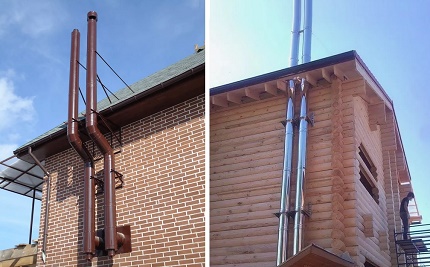
The pipe to the wall is fixed with brackets until it reaches the desired height. The process is completed by attaching the pipe to the boiler nozzle and sealing the joints. In order for the external chimney to warm up quickly, it is insulated with basalt cotton wool along the entire length.
Coaxial Chimney Installation
A chimney of this type discharges the combustion products to the outside and at the same time supplies the boiler burner with oxygen-rich air. With this design, no additional ventilation is needed.
The chimney is made of round pipes - outer steel with a cross section of 10 cm and a wall thickness of 0.1 - 0.2 cm and an inner aluminum with a diameter of 6 cm. The pipes do not touch because there are jumpers between them.
Mount coaxial chimneys for boilers with a closed combustion chamber, made for installation on the wall and floor, as well as for columns and other gas units.
Such a gas outlet has several advantages:
- structurally, the pipe is arranged so that simultaneously with the heating of the incoming air, the exhaust gases are cooled;
- the chimney increases the efficiency of the equipment;
- has compact dimensions, so they use it not only in private homes, but also in urban apartments;
- safe - the exhaust gases do not come in contact with the room air and exit not through the ventilation duct, but directly into the atmosphere;
- easy to install.
Install a coaxial chimney both horizontally and vertically. Regardless of the installation method, the maximum length of the chimney should not be more than 4 m. There are models with solid parameters, created specifically for the chimney over a long distance.
Directly for the installation of a coaxial chimney, manufacturers produce adapters of a special design used for vertical transitions through ceilings and roofs. To protect the system from precipitation and ensure tightness in the area where the pipe passes through the ceiling, there are special tips.
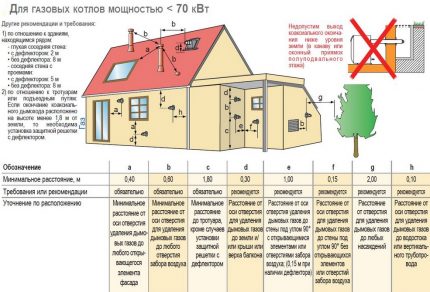
In the case of using a coaxial chimney for a boiler mounted on a wall, it is placed horizontally. In this case, it is necessary to provide a 3-5% slope, otherwise condensate will enter the boiler.
The standards regulate not only the size of the chimney for a gas boiler, but also the location of the hole in the wall. It should be removed from the window next to it by at least 50 cm and at least 25 cm if it is above the window.
How to remake an old chimney?
If a gas boiler is included in a long-existing heating system instead of a conventional furnace, a brick chimney does not have to be completely rebuilt. It can be upgraded by sleeve. There are two ways to do this.
Method number 1. Install a stainless steel pipe into the base of the existing chimney.
The pipe should be chosen so that its height is equal to the height of the old chimney, and the diameter corresponds to the boiler nozzle. The gap between the walls of the existing chimney and the pipe is filled with insulating material such as foam glass, expanded clay or perlite.
Method 2 Apply Furan-Flex technology. This option is more expensive than the first, but the diameter of the chimney remains unchanged. The material is frost-resistant, resistant to corrosion, diameter varies between 6 - 100 cm.
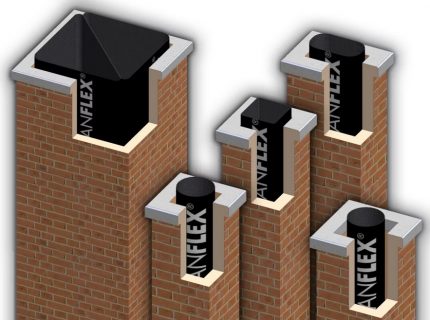
The technology itself is that an elastic pipe is placed inside the chimney under pressure. The pipe takes the form of a chimney, then hardens and becomes a continuous seamless shell that does not allow smoke or condensation.
Conclusions and useful video on the topic
Video # 1. A detailed overview of the installation of a coaxial chimney designed for a gas boiler can be seen in this video:
Video # 2. Here you will find useful information on how to choose a chimney, while avoiding common mistakes:
Video # 3. Video on eliminating violations of the chimney installation technology for a gas boiler:
Any household appliances, especially those operating on such an unsafe energy source as gas, must be installed in compliance with all the rules. A device for removing combustion products from gas boilers requires a competent approach. First, they carry out engineering calculations and only then implement the project, so it is better to entrust all this to specialists.
There are questions about the installation and installation of chimneys for a gas boiler, there are comments on the material, do you want to share your experience in the field of arranging a smoke channel yourself? Please write comments in the block below the text.

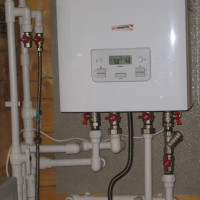 Connecting a double-circuit gas boiler to the heating system: requirements and norms + installation steps
Connecting a double-circuit gas boiler to the heating system: requirements and norms + installation steps 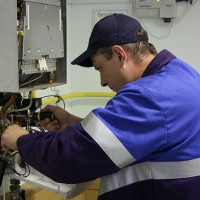 Replacing a gas boiler in a private house: norms and rules for completing the procedure for replacing gas equipment
Replacing a gas boiler in a private house: norms and rules for completing the procedure for replacing gas equipment 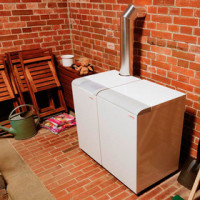 Do-it-yourself installation of a floor gas boiler: technical standards and algorithm of work
Do-it-yourself installation of a floor gas boiler: technical standards and algorithm of work 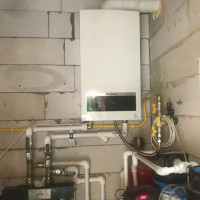 Grounding a gas boiler in a private house: standards, features of the device and checks
Grounding a gas boiler in a private house: standards, features of the device and checks 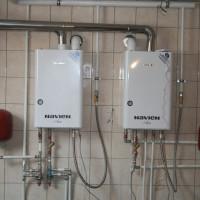 What determines the life of a gas boiler in a private house: what affects + life extension tips
What determines the life of a gas boiler in a private house: what affects + life extension tips 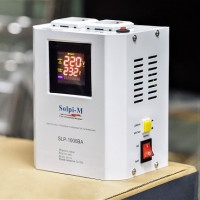 Voltage stabilizers for a gas boiler Baxi: TOP-12 of the best models according to consumers
Voltage stabilizers for a gas boiler Baxi: TOP-12 of the best models according to consumers  How much does it cost to connect gas to a private house: the price of organizing gas supply
How much does it cost to connect gas to a private house: the price of organizing gas supply  The best washing machines with dryer: model rating and customer tips
The best washing machines with dryer: model rating and customer tips  What is the color temperature of light and the nuances of choosing the temperature of the lamps to suit your needs
What is the color temperature of light and the nuances of choosing the temperature of the lamps to suit your needs  Replacement of a geyser in an apartment: replacement paperwork + basic norms and requirements
Replacement of a geyser in an apartment: replacement paperwork + basic norms and requirements
I agree with the author that for gas wall-mounted boilers, coaxial and combined chimneys are good, which can be brought to the wall or adapted to the structure of the house.
But, purely my opinion, there is nothing better than a brick chimney with condensate drainage, both in construction and in operation .. I will explain my idea. Today, everything is fine with gas, and tomorrow a dozen more houses will be built on your ShRP, and the pressure will drop. Or maybe they’ll come up with something else, which will make it cheaper to drown than gas.
With a brick chimney, you just change the boiler, with other chimneys you have to change both them and the boiler itself, and that's another story, as they say.
I want to lay a chimney from a gas boiler outside a one-story house with an attic. Does condensation work differently for indoor and outdoor flues or the same? If so hot smoke enters the chimney that even in summertime at plus atmospheric temperatures condensate forms, is there any way to deal with it? Are there any methods to reduce or even eliminate condensation?
It is impossible to exclude condensation, since water is released during the combustion process, but it can be reduced if you use sandwich pipes. It is better to drain the condensate from the outside. Then you simply will not notice it ...
Not a comment, a question. The outlet diameter of the gas boiler is 115 mm, the existing chimney is 100 mm. Your opinion - is it possible to attach using, for example, a smoke exhaust? Thank.
Hello. SNiP 2.04.05-91 and DBN B.2.5-20-2001. The cross section (diameter) of the chimney cannot be less than the outlet pipe on the boiler.
Can a coaxial chimney of a 20 - 24 kW boiler be placed vertically from the boiler room onto the roof of the house? The house is one story.
Hello. Yes, if it is provided for in the instructions for the device itself.
Everything, of course, is intelligibly told, but not all materials are always in our city. It remains as usual to install asbestos pipes. Gas service workers do not allow these pipes to be insulated. Everyone wants this chimney to last longer, and they insulate the min.vata. Hence the question: is it possible to insulate chimneys in this way to avoid condensation?
Hello. Why are gas workers not allowed? We have the opposite situation, for example. They bought a house last year, when they were still importing things, a specialist from the gas company said (the previous owners did not register a new gas boiler).
So, he examined all the equipment and the system, took the chimney seriously, saying that it wasn’t insulated with us - “wrap at least basalt cotton wool on the frame”.The flammability of the mineral wool is quite resistant material, there should be absolutely no problems.
In a two-story house, where initially there were wood boilers and later installed gas ones, the boilers were turned off. The grounds are an act of firefighters, they do not see the sky in the mirror. When examining the camera, it turned out that the chimney with ledges. But the craving is normal. Are firefighters legitimate?
Hello.
Firstly, firefighters could not dismantle and disconnect anything without drawing up special official acts, which you could read and even take a copy of (go to the Criminal Code, ask for such an act). The strange thing is, we doubt the actions of authorized persons, although we can verify the exact measurements and the justification by legal law. Or did you see the act, and not just hear about it? Then there should be no questions at all, the document has been drawn up and officially signed.
Secondly, it is difficult to answer your question without knowing what kind of ledges there are. According to the rules and regulations, the chimneys must be vertical with a permissible horizontal spacing of 30 degrees no more than 1 meter with smooth bends and a stable cross-section. In this case, inside the chimney there should not be any protrusions, inflows of mortar and other.
It seems to me that the actions of firefighters are not only legal, but they also have to be thanked for taking care of your safety.
For about 40 years, our two-story house has been heated by gas stoves laid out of red brick based on a clay-sand mixture with UGOP-16 burners.
A neighbor on the ground floor installed a double-circuit wall-mounted boiler with a closed combustion chamber with the output of combustion products into the existing chimney of his old furnace, which passes through our stove on the second floor. Under the roof, the chimneys of our furnaces were combined into a common asbestos-cement pipe.
From the very first year the gas boiler was operated by a neighbor, in winter there were problems with draft in my stove. By February, the connecting pipe above the ceiling was completely frosted with ice from condensate, and the boiler on the first floor continued to work and forced the combustion products into my furnace through a common pipe, and then into the living rooms.
I was forced to withdraw my chimney from the unifying pipe, making my own, separate exit. But this was not enough. As a result of erosion and destruction of the chimney channel by condensate from the boiler, the chimney has become leaky. And, therefore, in the winter period the pipe will freeze again, and the turbine will now push the combustion products through the loose walls of the chimney into my stove and then into the living rooms.
All attempts to force a neighbor to make a chimney liner and pipe insulation above the roof overlap were unsuccessful. In addition, in the month of June, he was successfully examined by a representative of the “Volcano” - after 10 minutes he wrote out an act of suitability and serviceability. At this time, all I could achieve was that the gas was turned off in the house, and a letter was sent to Vulkan to re-check the chimney.
Are there any regulations that were initially violated when installing this boiler? Just reading all the SNiPs and DBNs, it’s not entirely clear, but the manuals for the operation of such boilers, the steps for sleeve and insulation are translated into a recommendation ...
This year, we decided to install a new gas boiler in the apartment. And as I understand it, it is also necessary to install a chimney. For some reason, it seems to me that an external chimney may be suitable, in this case. Who knows if this is so? And which of these types of chimneys is more suitable for an apartment located on the second floor? Just do not want to take risks in this matter!
Last year we only installed a gas boiler in our house. He also chose for a long time between the asbestos-cement pipe and ceramics (he immediately excluded the steel from the options). Delivered from ceramics - it is the most reliable and durable.I think this option is most suitable for an apartment on the 2nd floor. Of course, the chimney is external, since in a high-rise building this is easiest to do.
SP 402.1325800.2018 Residential buildings. Rules for the design of gas consumption systems. Please read the application “G”.